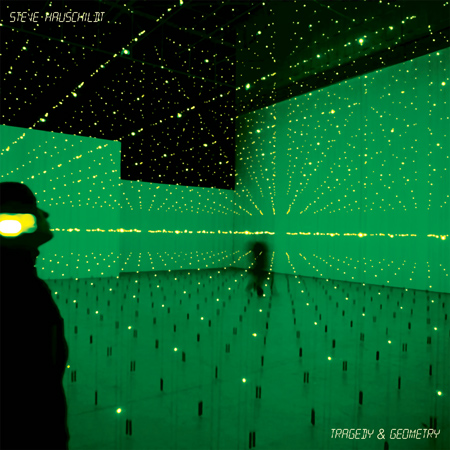 As the least prolific member of Cleveland kosmische collective Emeralds, Steve Hauschildt's first widely available (and officially pressed) solo release is long overdue. Recorded over three years, and released on Kranky in late 2011, the album is a twinkling gem—an hour's worth of vintage, Berlin-style electronics and ambience.
As the least prolific member of Cleveland kosmische collective Emeralds, Steve Hauschildt's first widely available (and officially pressed) solo release is long overdue. Recorded over three years, and released on Kranky in late 2011, the album is a twinkling gem—an hour's worth of vintage, Berlin-style electronics and ambience.
Tragedy and Geometry isn't leagues away from recent Emeralds recordings, like 2010's masterful Does It Look Like I'm Here?, but it utilizes a noticeably pared-down array of instruments. This being a solo album, variables like Mark McGuire's endlessly looped, delayed guitar explorations are stripped away, and Hauschildt's synthesizer is under the spotlight. Like Emeralds, Hauschildt's solo work draws heavily from the much-revered techniques of '70s Tangerine Dream, Ashra, Cluster, Klaus Schulze, and other giants of German electronic music and Krautrock. Given his winning resume with Emeralds, it's no surprise that Hauschildt executes beautifully on his own.
As a whole, Tragedy and Geometry is inviting, full of warm synthesizer textures and tones that pulse and glow like a distant satellite. Pieces like "Peroxide" and "Blue Marlin" are characteristic of how the album would sound condensed into a 3- to 4-minute highlight reel: deep, kosmische synthesizer tones are painted onto Hauschildt's aural canvas in broad strokes, highlighted by an ever-present, breathing ambience and a gentle, twinkling melody underneath. The title track follows nearly the same template, but punctuates itself with radiant synth rays that feel eternal, like they've always existed out there in the universe, and just now been captured onto tape.
The album's key strength (and its replayability) is in its almost mathematical adherence to melody. If Tragedy and Geometry were depicted as an image of the night sky, littered with stars, then each melodic pattern would be a constellation, simultaneously self-contained and part of the greater whole. By the same analogy, if there is any fault to be found, it's that the whole thing is a bit homogeneous: songs and sounds blur into each other, and earlier melodies are recalled in later ones (for example, "Already Replaced" echoes "Polyhymnia" almost identically at its start). As when the night sky casts out its glow by starlight, constellations can be picked out and observed; at the same time, at a glance, the whole sky kinda looks the same.
The moments that stand out, then, are Hauschildt's attempts to break the mold. "Batteries May Drain" marries a throbbing bass line with a krautrock-inspired drum loop, pushing Hauschildt's glittering, beatless melodies into a more traditional structure—a fine taste of how his work could evolve if he experiments with overt percussion. The album's centerpiece and desert-island selection, though, is the sprawling, 11-minute "Music for a Moiré Pattern," which takes the opposite route of Tragedy's more condensed pieces. Here, Hauschildt patiently builds the song's foundation for half its runtime before introducing sharp bursts of cosmic synth tones in three-note clusters, which pierce through the ambient fog like laser beams. It's a beautiful effect—as absorbing, hypnotic, and undeniably moving as the best moments in Emeralds' expansive catalog.
Samples:
Read More

